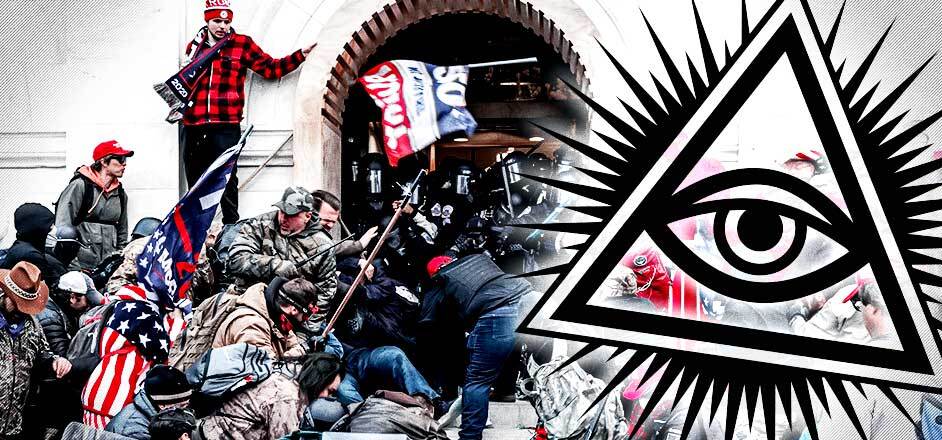It’s been eight months since that dark day when thousands of Trump supporters, Proud Boys, Q-cultists, forign spys and FBI agent provacetuers stormed the capitol and shocked the nation. They swarmed the building, easily breaching its high defenses, beating one police officer to death with a fire-extinguisher, assaulting others, forcing their way through doors, breaking windows, and ransacking Democratic offices throughout the facility.
But, of course, not all was as it seemed. For one, the Capitol was grossly (and notably) under-protected that day, despite well-known plans by Qanon and Proud Boy groups to do something violent following Trump’s rally. Anyone tied into conspiracy threads online, on Facebook, Reddit or 4Chan in the weeks leading up to the riot had seen posts and comments about “The Storm” and “The Plan” for January 6th — how had the all-seeing, all-knowing, omniscient government been caught so unaware and unprepared?
It also later became clear that the White House had actively slowed the deployment of the National Guard to the scene, once things started getting ugly. Had that been Donald Trump’s own call? Or were there higher intelligence powers at play that day, hindering the response?
Then, once inside (after police had removed barricades and stepped aside for the angry mob) the insurrectionists knew exactly where to go and how to get to specific offices of specific Democratic representatives within the capitol building. That is particularly strange, considering there are no floor maps, office numbers or names listed anywhere online or even inside the Capitol itself. That kind of information would be a serious security threat and is therefore kept tightly secret. So how did Trump’s moron-army know the way?
And then there’s the matter of police suicides. Just days after the riot, Officer Howard “Howie” Liebengood, 51, a 15-year veteran of the US Capitol Police (USCP), took his own life. Weeks later, he was followed by Metropolitan Police Officer Jeffery Smith, who likewise had responded to the Capitol attack. Then, last night MPD announced that Officer Gunter Hashida had been found dead by suicide a week prior. And just hours after that they announced a fourth: Kyle DeFreytag, who had apparently been found deceased in mid-July, but they’d waited to announce his suicide until now.
No details beyond the names of their surviving family members have been released. All that was reported in all four instances was “suicide.”
Sobering. Feeling compelled to share a resource for others who may be in need of support, as this may be triggering for some. The National Suicide Prevention Hotline is 800-273-8255. There is always someone available 24/7. https://t.co/0bweBgcbon
— leslifoster (@leslifoster) August 3, 2021
Now, before everyone straps on their tin-foil hats, it’s worth noting that police officers do have a relatively high rate of suicide, compared to other professions. Sure, it isn’t as high as construction workers or miners — in fact, it isn’t even on the top-five listed by the CDC. Still, a lot of police officers kill themselves every year. One study done by The Ruderman Family Foundation found that police officers are actually more likely to die by suicide than in the line of duty.
However, the rate of suicide among the police officers who responded to this event is abnormally high. Within eight months of the Capitol riot, four officers had taken their own lives — one of whom wasn’t announced publicly as having done so, for weeks after his death. All of these officers were long-time veterans of their departments. Yet something about this particular event was so traumatizing it drove them to their wit's end.
Of course, it does no good to speculate on reasons why someone takes their own life — particularly people who work in high-stress jobs like police officers. These suicides might have had nothing to do with the Capitol riot at all.
“Correlation does not equal causation,” as my publisher tells me.
But at the same time — the Capitol Riot is one of those grim historical events that will go down in history surrounded by big, dark question marks: Why wasn’t the insurgent mass of insurrectionists expelled by the government’s superior security? Where was the use of force in defense of one of our nation’s most sacred spaces? How come everyone online knew this was going to happen, and yet the government was somehow out of the loop? Why did police remove their barricades to let rioters in? How did the insurrectionists know their way around the capitol building so intimately!?
And why have so many of the responding officers taken their own lives in the following months?
That last question is starting to sound more dubious with each new case of apparent suicide. Particularly in light of some other recent high-profile, and very suspicious “suicides” — like Jeffery Epstein and John McAfee. There seems to be a pattern emerging of people getting too close to a shady and mysterious government-related situation and then suddenly, unexpectedly taking their own lives. Perhaps these officers saw something, or learned something, that they shouldn’t have and ended up on the Government’s “suicide hit list.” Perhaps they’d been involved in some of the coup logistics and represented loose ends that needed “tying up.” Perhaps they learned an ugly truth about their government and their country that they simply couldn’t live with.
Again, correlation doesn’t equal causation — but from time to time, it can be a good indicator. There seems to be ample circumstantial evidence that unseen forces were stoking the fires of that January 6th riot: whether it was Trump himself, the FBI attempting a government coup, foreign adversary interference, or shadow government intervention, we may never know.


Leave a Reply
You must be logged in to post a comment.